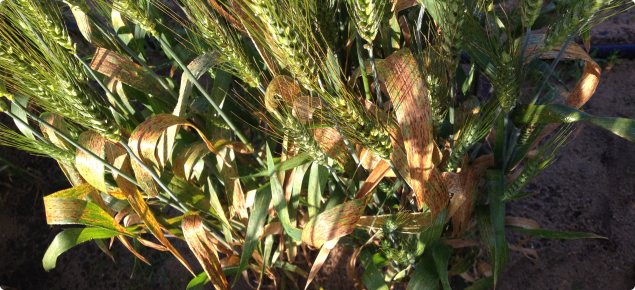Background
Septoria nodorum blotch (SNB) caused by the fungal pathogen Stagonospora nodorum is rated as the second most significant necrotrophic fungal disease of wheat in Western Australia with an average 9% yield loss at an estimated annual cost of $108 million to wheat growers across the wheatbelt.
Although cultural and fungicide management practices have contributed to decreasing severity of the disease in wheat production, increasing on-farm production costs has prompted the need to develop wheat varieties with effective resistance to SNB.
Previous GRDC investments through projects DAW00089 and DAW00126 made significant advances in identifying novel sources of resistance to SNB in flag leaf and glumes. Knowledge and resources to manipulate the genetic control of adult plant resistance can be used to develop appropriate SNB resistance in wheat varieties. Therefore, this project (DAW00248 commenced July 2015, completing February 2021) will evaluate international wheat germplasm for consistent SNB resistance in multi-environment successive year trials, identify the genetic basis and identify molecular markers for flag leaf and glume resistance, deploy and validate effectiveness of combining different genes from existing and new genetic sources that will enhance SNB resistance in Australian wheat varieties.
Project need
Resistance to SNB has been identified in wheat but new sources in global wheat germplasm are also being sought that are effective aginst contemporary isolates. There is a need, therefore, to combine genes from unadapted wheat lines into Australian varieties and apply DNA marker technologies to track and select lines with different gene combinations. Selected lines need to be evaluated in field trials for validation that specific gene combinations express enhanced resistance in Australian wheat production environments. Proof-of-concept will increase the probability of breeding companies adopting genes and associated DNA markers for commercial variety development. Moreover, there is a continuing need to evaluate new wheat germplasm effective in WA production environments.and against contemporary isolates causing SNB.
Project aims
- Evaluate Australian and international germplasm for effective SNB resistance expressed in different Western Australian production environments that can be used as donor parents in germplasm development and commercial breeding.
- Identify the genetic basis and SNP markers associated with flag leaf and glume resistance expressed in different environments against contemporary isolates of the pathogen.
- Deploy existing and new resistance genes from global wheat accessions into Australian cultivars, select lines using SNP markers and identify single or gene combinations that will make significant improvements in flag leaf and glume resistance.
- Evaluate and identify wheat germplasm with single or combined genes that express improved SNB resistance in Australian wheat production environments.
Project deliverables
- SNB resistance rankings for Australian commercial cultivars, international accessions, landraces made available to Australian wheat breeding companies (see SNB Database Entries in Documents section).
- SNP markers used to track and select gene combinations for enhanced SNB resistance delivered to Australian breeding companies for use in marker assisted breeding (see SNP marker protocol).
- Candidate gene markers identified for SNB resistance in response to specific Western Australian production environments against historical and contemporary isolates.
- New wheat germplasm with gene combinations in Australian genetic backgrounds validated for improved SNB resistance in Western Australian production environments and delivered to Australian breeding companies for commercial variety development.
Project update
Activities in 2019 validated expression of resistance in global germplasm accessions in multi-environment trials and identified alternative sources of SNB resistance, generated new data and delivered necessary resources for commercial breeding of new wheat varieties with enhanced SNB resistance for Western Australia. These included:
- Evaluation of 239 global wheat lines from CIMMYT, ICARDA and landraces for flag leaf and glume SNB resistance benchmarked against historical and recently released Australian commercial wheat varieties at Katanning and Manjimup in 2019 (see attached Database Entries SNB file). Moderate correlation for flag leaf response between multi-location trials in 2016-2019 and high correlation for glume response in 2018-2019.
- Wheat accessions 30ZJN09, ZJN12Qno25 and ZWW10Qno157 consistently expressed flag leaf SNB resistance in multi-location trials in 2016-2019.
- Lines with consistent low flag leaf disease and additional CIMMYT inbred lines including ZVS07Qno227, ZWW09Qno125, ZJN11Qno29, ZJN10Qno12 and ZEE10Qno77 showed consistent low glume disease in 2018-2019.
- Inbred lines selected for stacked QTL for flag leaf SNB resistance showed lower disease symptoms than those with single QTL.
- Significant genotype-by-environment-by isolate interactions for flag leaf SNB response. Genetic analysis identified multiple QTL detected in specific years and locations indicating numerous genes respond independently to different SNB isolates and environments.
- Candidate genes have been identified that respond specifically to SNB in different environments and against different isolates.


